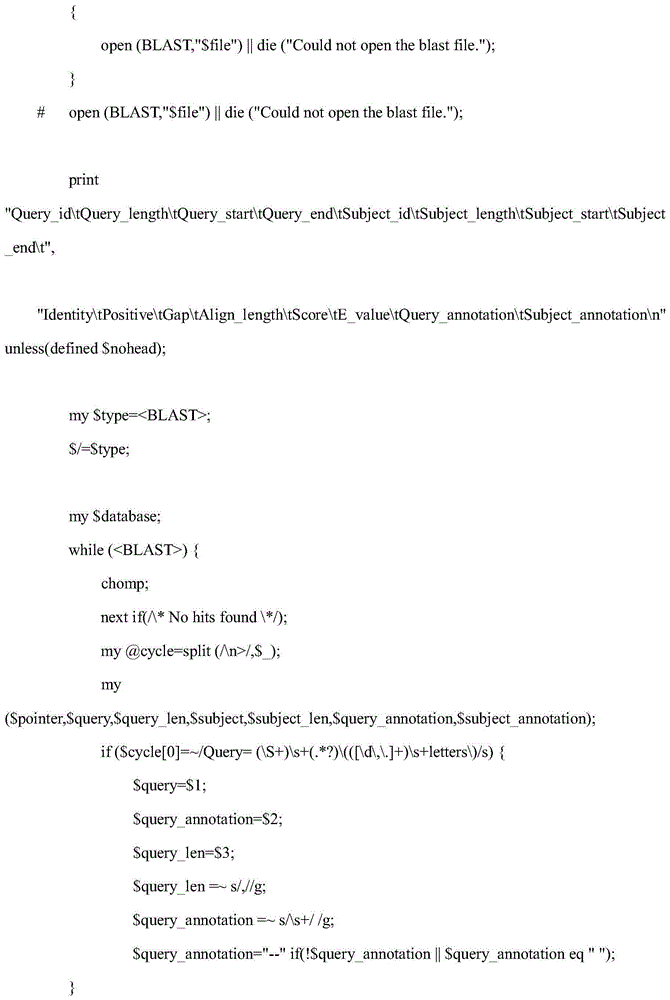Electric FISH (fluorescence in situ hybridization) method
An electronic and probe sequence technology, applied in the field of bioinformatics, can solve problems such as large consumption of experimental materials, experimental failure, and unsatisfactory results, and achieve the effect of convenient statistical analysis.
Inactive Publication Date: 2015-01-28
INST OF COTTON RES CHINESE ACAD OF AGRI SCI +1
View PDF6 Cites 0 Cited by
- Summary
- Abstract
- Description
- Claims
- Application Information
AI Technical Summary
Problems solved by technology
[0003] However, fluorescence in situ hybridization experiments often have high requirements on the experimental skills of the experimenters. A slight error in the experimental process will lead to the failure of the experiment, the result is not ideal, and the experiment needs to consume a lot of experimental materials.
Method used
the structure of the environmentally friendly knitted fabric provided by the present invention; figure 2 Flow chart of the yarn wrapping machine for environmentally friendly knitted fabrics and storage devices; image 3 Is the parameter map of the yarn covering machine
View moreImage
Smart Image Click on the blue labels to locate them in the text.
Smart ImageViewing Examples
Examples
Experimental program
Comparison scheme
Effect test
Embodiment 1
[0016] Example 1 With the cotton BAC 299N22 clone as a probe, Raymond cotton (D 5 ), Asian cotton (A 1 ) genome as the target DNA for electronic FISH. Then Raymond cotton (D 5 ), Asian cotton (A 1 ) mitotic metaphase chromosome as the target DNA for FISH verification.
[0017] 1 Materials and methods
[0018] 1.1 Experimental materials
the structure of the environmentally friendly knitted fabric provided by the present invention; figure 2 Flow chart of the yarn wrapping machine for environmentally friendly knitted fabrics and storage devices; image 3 Is the parameter map of the yarn covering machine
Login to View More PUM
 Login to View More
Login to View More Abstract
The invention belongs to the field of biologic information science and particularly relates to an electric FISH (fluorescence in situ hybridization) method. The method comprises the following steps of performing sequence alignment by taking a probe sequence as a search sequence and a target sequence as a database sequence; modifying comparison results by using Perl script blast_parser.pl; deleting the results which are relatively short in segments and relatively poor in consistency from the comparison results; making a scatter plot diagram by taking positions of the probe sequence and the search sequence on the target sequence as ordinates and taking comparison times as abscissas. The method is simple and convenient in operation, the results are reliable and precise due to the fact that the results are verified by real FISH, the time and the cost are reduced, and the resolution is high and the pertinency is high due to the fact that a target DNA (deoxyribonucleic acid) can be a genome, a single chromosome, a specific sequence segment and the like.
Description
technical field [0001] The invention belongs to the field of bioinformatics, and in particular relates to an electronic FISH method. Background technique [0002] Fluorescence in situ hybridization technology was born in the late 1960s. Its principle is to use the principle of complementary base pairing to physically locate probe DNA to target DNA such as chromosomes, interphase nuclei, and DNA fibers. At present, fluorescence in situ hybridization technology is widely used in the physical location of genes, chromosome identification, physical map construction, kinship research and transgenic detection, etc., and has an irreplaceable position in the field of modern molecular cytogenetics. [0003] However, fluorescence in situ hybridization experiments often have high requirements on the experimental skills of the experimenters. A slight error in the experimental process will lead to the failure of the experiment, the result is not ideal, and the experiment needs to consume ...
Claims
the structure of the environmentally friendly knitted fabric provided by the present invention; figure 2 Flow chart of the yarn wrapping machine for environmentally friendly knitted fabrics and storage devices; image 3 Is the parameter map of the yarn covering machine
Login to View More Application Information
Patent Timeline
 Login to View More
Login to View More Patent Type & Authority Applications(China)
IPC IPC(8): G06F19/22G06F19/20
Inventor 崔兴雷刘方彭仁海蔡小彦王星星周忠丽王春英王玉红刘玉玲王坤波
Owner INST OF COTTON RES CHINESE ACAD OF AGRI SCI
Features
- R&D
- Intellectual Property
- Life Sciences
- Materials
- Tech Scout
Why Patsnap Eureka
- Unparalleled Data Quality
- Higher Quality Content
- 60% Fewer Hallucinations
Social media
Patsnap Eureka Blog
Learn More Browse by: Latest US Patents, China's latest patents, Technical Efficacy Thesaurus, Application Domain, Technology Topic, Popular Technical Reports.
© 2025 PatSnap. All rights reserved.Legal|Privacy policy|Modern Slavery Act Transparency Statement|Sitemap|About US| Contact US: help@patsnap.com



